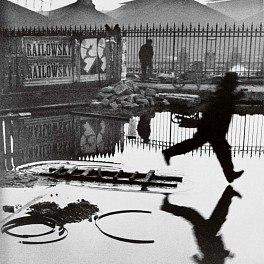BIOGRAPHY

1908 - 2004
Regarded as one of the greatest photographers of the 20th century. He elevated "snap shooting" to the level of a refined and disciplined art. His sharp-shooter's ability to catch "the decisive moment", his precise eye for design, his self-effacing methods of work, and his literate comments about the theory and practice of photography made him a legendary figure among contemporary photojournalists. He helped develop the "street photography" style that has influenced generations of photographers that followed.
Henri Cartier-Bresson was born in Chanteloupe-en-Brie, near Paris, France, the eldest of five children. His father was a wealthy textile manufacturer. He also sketched in his spare time. The Cartier-Bresson family lived in a bourgeois neighborhood in Paris, near the Europe Bridge, and provided him with financial support to develop his interests in photography in a more independent manner than many of his contemporaries.
At the age of 19, Cartier-Bresson entered a private art school and the Lhote Academy, the Parisian studio of the Cubist painter and sculptor André Lhote. He regarded Lhote as his teacher of photography without a camera. The rigorous theoretical training would later help him to confront and resolve problems of artistic form and composition in photography.
From 1928 to 1929, Cartier-Bresson attended the University of Cambridge studying English art and literature and became bilingual. When World War II erupted, he served briefly in the French Army and was captured by the Germans during the Battle of France. After two unsuccessful tries, he escaped from the camp where he was held as a prisoner of war, and worked with the underground until the war's end.
Resuming his interrupted career as a photojournalist, he helped form the Magnum picture agency in 1947. Assignments for major magazines would take him on global travels, across Europe and the United States, to India, Russia and China.
Cartier-Bresson achieved international recognition for his coverage of Gandhi's funeral in India in 1948 and the last stage of the Chinese Civil War. In 1968, he began to turn away from photography and return to his passion for drawing and painting. He completely retired from photography in the early 1970s and no longer took pictures other than an occasional private portrait; he said he kept his camera in a safe at his house and rarely took it out.
Cartier-Bresson died in Céreste, France in 2004, at 95. The Henri Cartier-Bresson Foundation was created by Cartier-Bresson, his wife and daughter in 2002, to preserve and share his legacy.
